Categories
Subjects
Authors
Artists
Venues
Locations
Calendar
Filter
Done
January 18, 2022 – Review
Claudia Gutiérrez Marfull’s “There is No Paradise Without Snakes”
Gaby Cepeda
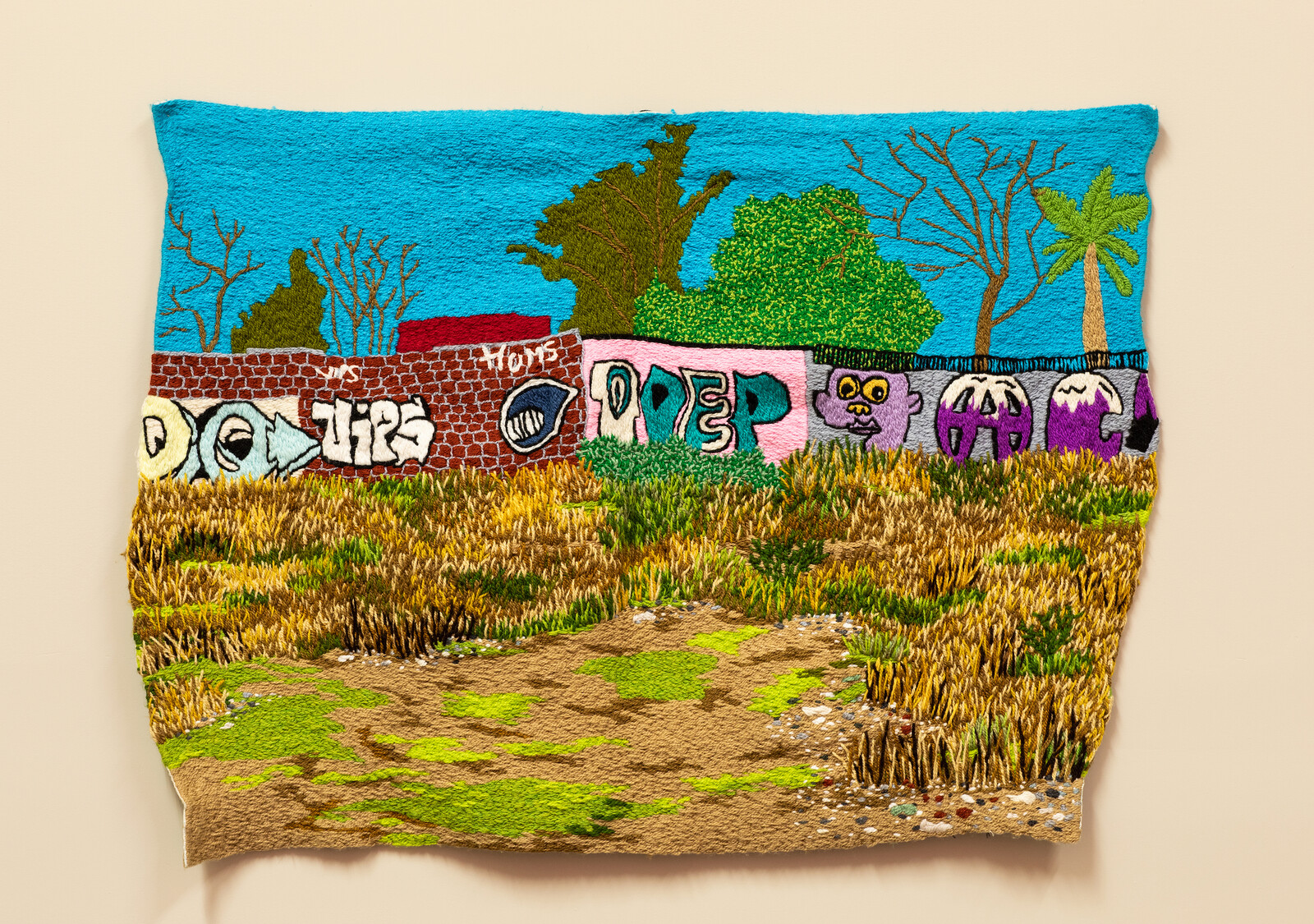
The idea of the periphery implies a metropolitan center around which everything revolves. As cities become ever-more expensive and policed, they effectively turn their poorer citizens into an extrinsic workforce, pricing them out of central areas and forcing them to commute. Claudia Gutiérrez Marfull’s textiles capture the sorts of exurban landscapes that workers who live in the peripheries are likely to witness daily. Her delicate embroideries in “No hay paraíso sin serpientes” [There is no paradise without snakes], made with chunky acrylic and natural wool on Aida cloth, depict neglected areas of Puente Alto, the most populous commune in Chile, on the edge of Santiago.
In one of the two 2020 works whose shared title lends the show its name, Gutiérrez Marfull represents an overpass leading nowhere atop a dry stream bed using tight, colorful stitches. The weeds are tall, the concrete bridge mossy. Graffiti dots the area, as do a few trees. A few dark, elongated clouds cross the blue sky. In the second embroidery of the same title, a graffitied concrete wall obscures everything but the red roof of a beige building standing in the background. Beneath the gray sky, a couple of yellow trees sit in …
June 9, 2016 – Review
Nicholas Mangan’s "Ancient Lights"
Claudia Arozqueta
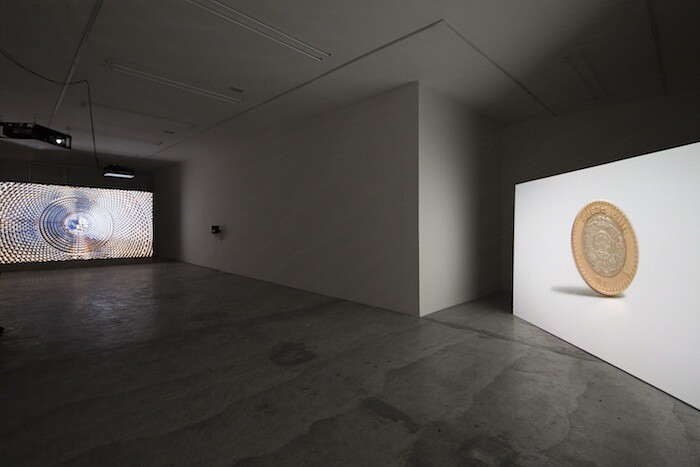
As the central body in our planetary system, the sun has been revered through history as the source of our energy and the basis of our calendars. “Ancient Lights,” Nicholas Mangan’s first solo exhibition in Mexico City, is a sun worshipper’s investigation into the myriad conceptions of our star, from the theological to the technological. It features an installation of two new films (both Ancient Lights, 2016), projected one in front of each other at different angles in this L-shaped gallery, which explore the unstable relationship between humanity and nature as well as different kinds of energies: motion, sound, electricity, and magnetism.
Scientists have long considered how solar variations—like sunspots—might relate to changes in climate and associated human activities. Mangan’s first film—displayed close to the gallery entrance on a suspended wall, at 90-degree angle to the room’s right wall—charts and compiles these investigations. The 13-minute loop presents a montage of different footage: the sun reflecting off the heliostats at the Gemasolar Thermosolar Plant in Andalucía; the air contamination visible in the skyline of Mexico City; audiovisual data from NASA’s Solar and Heliospheric Observatory project, which tracks the relationship between sunspots and weather changes; oranges covered in frost during an unseasonable cold …
April 21, 2014 – Review
Terence Gower’s “Baghdad Case Study”
Adam Kleinman
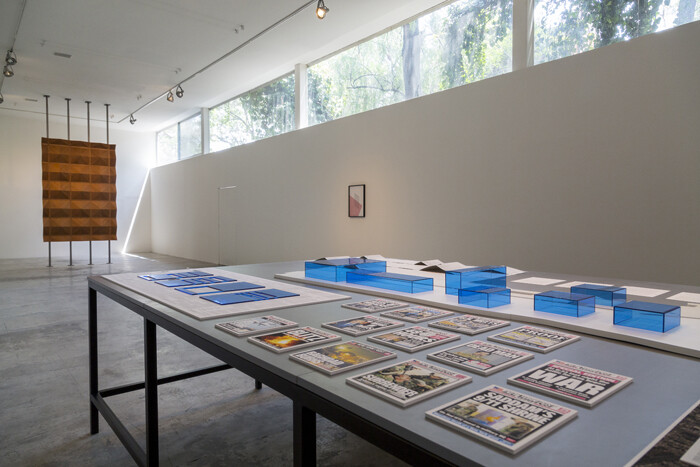
On May 13, 1846, United States President James K. Polk went before Congress and asked for a declaration of war against Mexico. His rallying cry: “American blood has been shed on American soil.” While eleven Americans were killed and six more were wounded in what is now known as the Thornton Affair, the official Mexican response considered the skirmish as an act of US aggression that actually took place south of the border. Whether or not the American people had been deceived, Polk—whose administration had already started plotting just such a war in advance—found his necessary pretext, and with it, America’s historic march into expansion-by-force began in earnest. If this strategy sounds oddly familiar, it might be wise to remember that March 20, 2014 was the eleventh anniversary of the second US invasion of Iraq, a premeditated war drummed up by the upper echelons of the US government in “response” to events that might not have happened exactly the way they said they did. By way of trans-historical testament, it is most fitting that Canadian artist Terence Gower now presents his Baghdad Case Study (all works 2012/14)—an encyclopedic work that parallels various post-WWII histories of US interventionism—in Mexico, the very …
July 23, 2012 – Review
"Sinking Islands"
Tyler Coburn
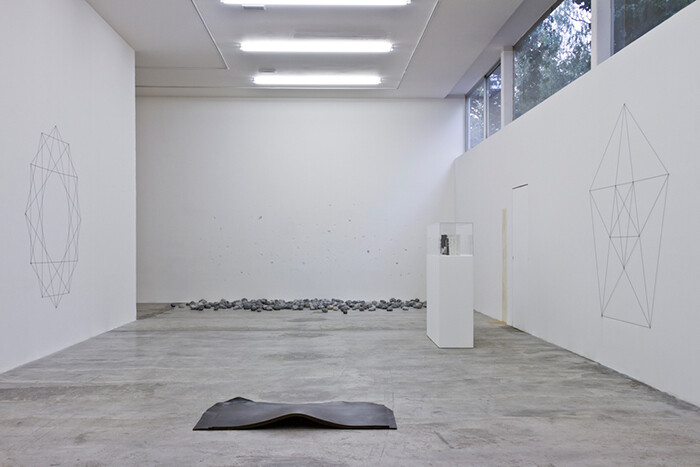
With Katinka Bock, Etienne Chambaud, Hernán Díaz, Fabien Giraud, Karl Holmqvist, The Institute for Figuring, and Nicholas Mangan.
In the keynote essay for “Sinking Islands,” on view at LABOR, Mexico City, curator Vincent Normand provocatively asks, “What would be an exhibition of things flat-out alone, requiring the presence of no one?” We subjects of modernity, it would seem, are the problem this group exhibition seeks to critique, less in directly attacking the discursive means by which we have named and, thus, delimited the world, than by presenting objects that attempt radical breaks from signification, dipping beneath semiological horizons by weight of material intransigence. On account of their resistance to making sense for us, these objects assert a non-anthropocentricity that supposedly demands a self-othering, a becoming-savage of us exegetes. While Normand’s rhetorically encumbered text claims to depart from the promise of Utopia that, in cases like Thomas More, once anchored this topographical conceit, his wish for an insular thingness, in “the ocean of signs,” offers, at best, a cogent prompt of the exhibition’s works; and, at worst, a call-to-withdrawal befitting the conservative position of this cultural moment.
“Sinking Islands” takes form as both an exhibition and takeaway book, the latter of which shares …
April 19, 2012 – Review
Zona Maco
Kate Sutton
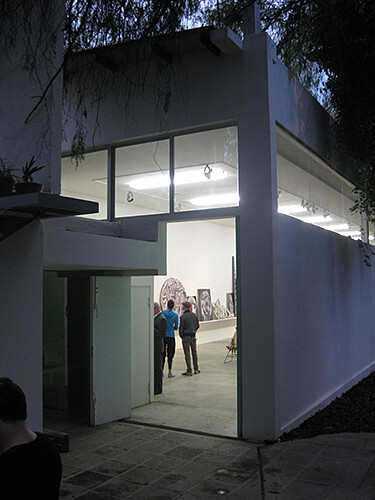
Art fairs—unlike biennales—aren’t allowed the luxury of an “off year.” And so it is that Zona Maco finds itself sandwiched between two Very Big years—with the opening of Carlos Slim’s Soumaya Museum last year and the debut of the David Chipperfield-designed facilities for La Colección Jumex slated for 2013. Now in its eighth year, the fair provides a much more relaxed alternative to Art Brussels and Art Cologne. But just because a fair takes lunch breaks—four hour ones at that, and always at Contramar—doesn’t mean it can’t be taken seriously.
As the Soumaya and Jumex museums chart out new territory for art in the city, galleries and smaller projects are gravitating towards older ones. In the Ampliación Daniel Garza area, just south of Chapultepec Park, Casa Luis Barragán serves as the elegant anchor for a fresh crop of initiatives, two of which opened Monday, two days before the fair. I started off at Labor’s new space, housed in the former workshop of Soumaya architect Fernando Romero, who has since moved next door to Casa Barragán, directly across the street. “I love how this address acts as a type of filter,” Labor’s Pamela Echeverria sighed between sips of mescal. “The type of …